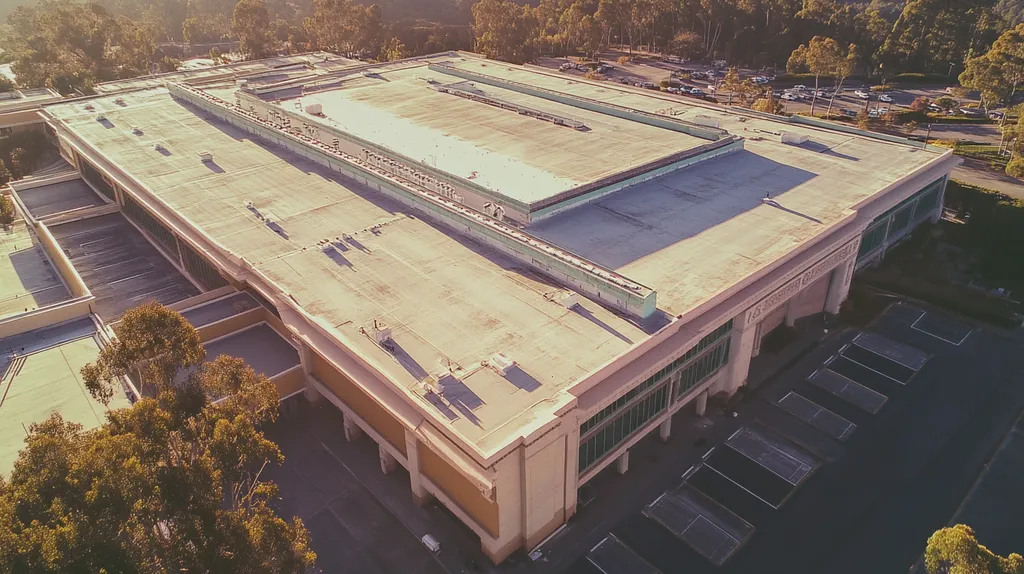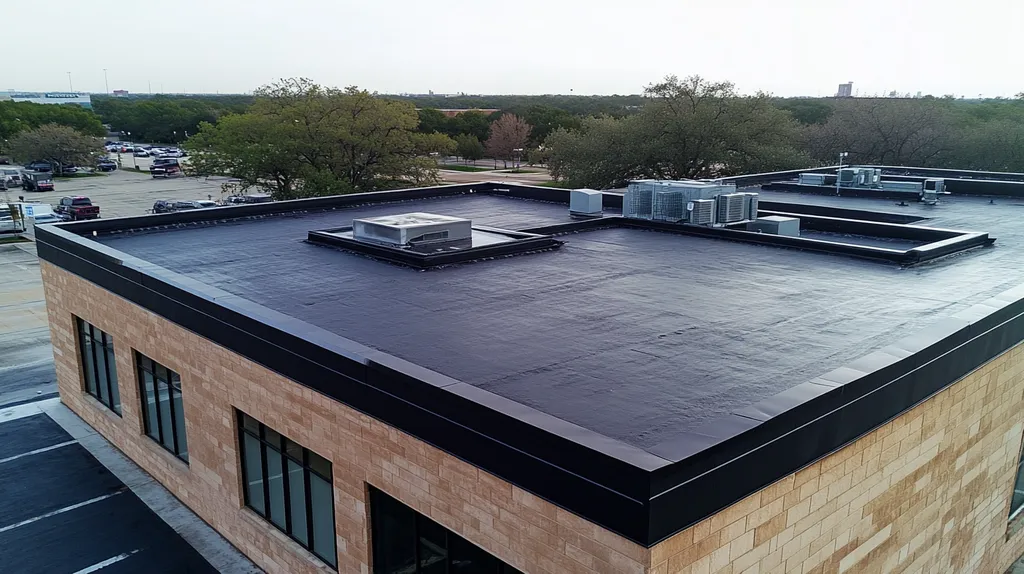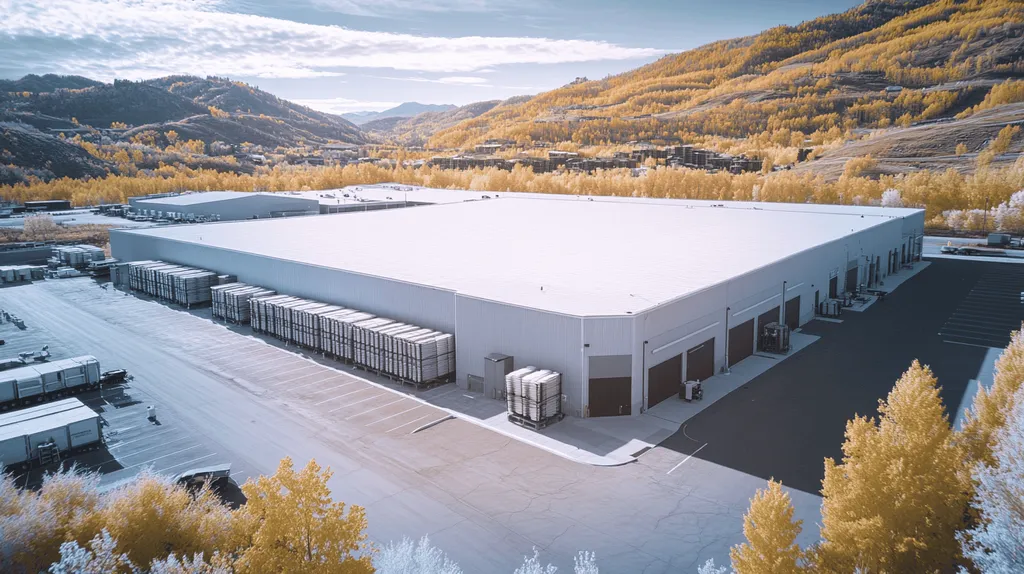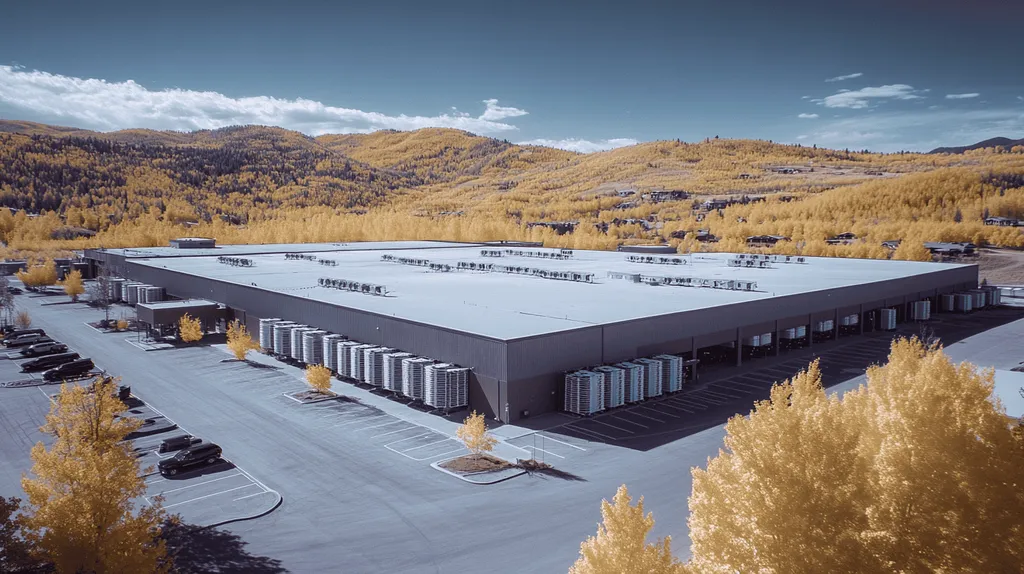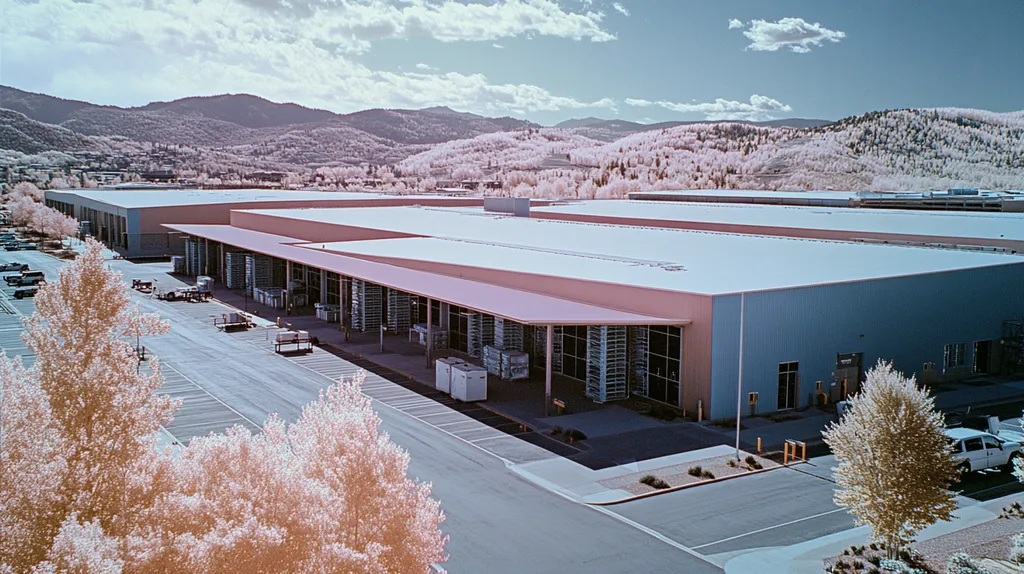In an industry where billions of dollars ride on rooftop decisions, property owners are discovering an uncomfortable truth: standard ROI calculations for commercial roof coatings are failing spectacularly. Current models routinely underestimate actual costs by 40-60% while missing critical value drivers that could make or break the investment.
Like using a 1950s road map to navigate modern highways, traditional formulas ignore crucial factors such as regional climate variations, maintenance realities, and property value impacts.
This comprehensive analysis exposes the systemic flaws in current ROI practices while introducing next-generation approaches that capture the true value of commercial roof coating investments.
SECTION 1: CURRENT PRACTICES
Ever wondered why some building owners jump for joy about their roof coating investment while others feel like they’ve been left out in the rain? The answer lies in how we crunch the numbers. Right now, the commercial roofing industry is stuck using ROI calculations that are about as precise as measuring rainfall with a pasta strainer – they let too much valuable data slip through the cracks!
Standard ROI Formulas Used in Commercial Roof Coatings
The current ROI calculation playbook reads like a “one-size-fits-all” instruction manual, when really, every roof tells its own unique story. Most calculations simply divide total anticipated savings by installation costs, treating every building as if it were identical twins.
Picture this: a warehouse in Phoenix and an office building in Seattle using the same ROI formula. It’s like expecting a sunhat and a rain jacket to provide the same protection! These oversimplified calculations ignore crucial factors like building usage patterns, local climate conditions, and specific coating performance characteristics.
Speaking of oversimplification, many current formulas treat energy savings like a magic number that applies equally to all buildings. In reality, energy savings can vary as dramatically as summer utility bills between Death Valley and Alaska.
Common Cost and Savings Metrics Incorporated
Though commercial roof coatings have higher initial costs than traditional roofing materials, they can yield substantial savings in the long run through benefits like energy savings from cool roofs and lowered maintenance expenses. (source: SmartSeal)
Current metrics often focus on the obvious costs – installation, basic maintenance, and occasional repairs. But they’re missing the hidden treasure chest of indirect benefits, like reduced HVAC wear-and-tear or improved indoor comfort that keeps productivity sailing smoothly.
Think of these metrics as a roofing report card that only grades the final exam, ignoring all the homework and class participation. They typically overlook the cumulative impact of preventive maintenance, which is like ignoring compound interest in your savings account.
Prevailing Assumptions in Lifecycle and Energy Benefit Estimates
Today’s lifecycle estimates often treat roof coatings like they’re operating in a laboratory instead of the real world. They assume perfect installation, ideal weather conditions, and textbook maintenance schedules – about as realistic as expecting your morning commute to always take exactly 20 minutes.
These assumptions frequently ignore regional weather patterns, treating a coating in humid Florida the same as one in arid Arizona. It’s like expecting the same sunscreen to work equally well at the beach and in the mountains.
Most troubling is the tendency to treat all coatings as carbon copies of each other. This oversimplification is like saying all cars get the same gas mileage – it ignores quality differences that can significantly impact long-term performance and value.
The current estimation methods also tend to freeze energy costs in time, as if utility rates were as unchanging as the law of gravity. This static view can seriously undervalue the future benefits of energy-efficient coatings in a world where energy costs typically rise faster than inflation.
SECTION 2: SYSTEMIC ISSUES
Ever feel like your roof coating calculations are missing something important? Like trying to predict the weather with just a thermometer, traditional ROI calculations for commercial roof coatings leave out critical factors that can make or break your investment. From sunshine to snowstorms, every roof faces unique challenges that standard formulas simply don’t address.
Overreliance on Short-Term Energy Savings Projections
Think of short-term energy savings like a sugar rush – they might look great at first, but they don’t tell the whole story. While cool roof coatings can deliver impressive initial utility bill reductions, focusing solely on these immediate gains is like counting your chickens before they’ve survived their first storm.
Many property owners get starry-eyed over projected energy savings without considering the coating’s performance over time. Just as a car’s fuel efficiency drops without proper maintenance, a roof coating’s energy-saving properties can deteriorate if not properly maintained.
The reality is that energy savings fluctuate based on countless variables, from seasonal changes to building occupancy patterns. What works like magic in July might barely register in December.
Smart facility managers know that chasing short-term savings without considering long-term performance is like buying a sports car without checking the maintenance costs – exciting at first, but potentially painful later.
Neglect of Maintenance and Longevity Variability Factors
Here’s a truth bomb: roof coatings aren’t “set it and forget it” solutions. They’re more like a garden that needs regular attention to thrive, yet many ROI calculations treat them like plastic plants that never need water.
The lifespan of a coating can swing wildly based on factors that standard calculations ignore. UV exposure, temperature swings, and foot traffic can all accelerate aging faster than a banana in the sun.
Maintenance quality makes a huge difference too. A well-maintained coating might sail past its warranty period, while a neglected one could fail before you’ve finished paying for it.
Even the initial application process can make or break performance. It’s like baking a cake – the same ingredients can produce drastically different results depending on who’s doing the mixing.
Ignoring Regional Climate and Building-Specific Conditions
Would you wear a winter coat in Miami? Of course not! Yet many ROI calculations treat all roof coatings like they’re working in the same environment. A coating that’s a superhero in Arizona might be a washout in Seattle.
Building design throws another wrench in the works. Roof slope, ventilation, and even the color of your walls can impact how a coating performs. It’s like expecting the same sunscreen to work equally well on the beach and in the mountains.
Different industries bring different demands too. A coating that’s perfect for a retail store might be completely wrong for a food processing plant or a cold storage facility.
Smart ROI calculations need to account for these regional and building-specific factors. Just as you wouldn’t trust a weather forecast from 1,000 miles away, you shouldn’t rely on ROI calculations that ignore your local conditions.
SECTION 3: MISSED OPPORTUNITIES
Want to hear something shocking? While property owners obsess over energy savings from roof coatings, they’re often missing out on benefits worth far more than a lower utility bill. It’s like focusing on the sprinkles while ignoring the whole ice cream sundae! From boosted property values to tax windfalls, these overlooked opportunities could be the difference between a good investment and a great one.
Underestimating Roof Coating’s Impact on Property Value
Think your roof coating just keeps the rain out? Think bigger! A well-maintained coating system can boost your property’s market value like a fresh coat of paint in a home’s kitchen – but with much bigger numbers at stake.
Modern buyers aren’t just kicking the tires anymore – they’re scrutinizing every aspect of building performance. A properly coated roof signals that this property is ready for the future, not stuck in the past.
The magic happens when potential buyers calculate operational costs. A building with lower cooling needs and documented maintenance history practically sells itself compared to energy-hungry alternatives.
Even better? These value boosts compound over time like a savings account on steroids, especially in markets where green buildings command premium prices.
Failure to Account for Insurance and Tax Incentive Benefits
Here’s a head-scratcher: why do so many property owners leave money on the table by ignoring insurance perks and tax benefits? It’s like having a winning lottery ticket and forgetting to cash it in!
Insurance companies love roof coatings almost as much as they love not paying claims. Many offer significant premium reductions for buildings with protective coating systems, but you have to know to ask.
The tax situation is even juicier. Local, state, and federal incentives for energy-efficient upgrades can turn what looks like a costly project into a financial home run.
Smart property owners are discovering that these “hidden” benefits can sometimes cover half the project cost – making that ROI calculator work overtime!
Overlooking Tenant Retention and Marketability Enhancements
Let’s talk about the elephant on the roof: happy tenants pay their rent, and unhappy ones move out. A quality roof coating doesn’t just protect your building – it protects your revenue stream.
When tenants experience fewer disruptions from leaks and enjoy more consistent indoor temperatures, they’re more likely to stick around. It’s like giving them a reason to renew their lease without having to slash your rates.
Marketing wizards know that “green building” isn’t just a buzzword – it’s a powerful tool for attracting premium tenants. Environmental consciousness sells, especially to corporate clients with sustainability goals.
The best part? While your competitors struggle with vacancy rates, your coated roof could be silently working as your best leasing agent, attracting and keeping quality tenants who value well-maintained properties.
SECTION 4: ROOT CAUSES
Ever tried to solve a puzzle with pieces from different boxes? That’s what calculating ROI for roof coatings feels like right now! Property owners are struggling to make sense of conflicting data, inconsistent measurements, and communication gaps that make accurate financial planning about as easy as catching raindrops in a colander. With millions of square feet of commercial roofing at stake, getting these calculations right isn’t just about numbers – it’s about protecting valuable assets and making smart investments that stand the test of time.
Lack of Standardization in ROI Data Collection Methods
Picture ten different contractors measuring the same roof with ten different rulers – that’s essentially what’s happening with ROI calculations today. Some count energy savings from day one, while others factor in a gradual performance curve, creating a metrics mess that would make a mathematician cry.
Without standardized measurement protocols, comparing different coating options becomes like comparing apples to oranges to bananas. Property owners end up making decisions based on mismatched data sets that don’t tell the whole story.
Even worse, this lack of standardization means that success stories from one building might be completely irrelevant for another. It’s like using a desert survival guide for a trip to the Arctic!
What looks like a stellar ROI in one calculation might barely break even in another, leaving property owners scratching their heads and second-guessing their investments.
Inadequate Integration of Total Cost of Ownership Models
Too many facility managers are stuck playing a short-term numbers game when they should be thinking marathon, not sprint. Basic ROI calculations often ignore critical factors like maintenance frequency, repair costs, and performance degradation over time.
Imagine buying a car based solely on the sticker price, without considering fuel efficiency, maintenance costs, or resale value. That’s exactly what happens when total cost of ownership gets left out of the roofing equation.
The real kicker? These simplified calculations can make premium coatings look overpriced when they’re actually the bargain of the century. It’s like passing up a quality coffee maker for a cheaper model, only to spend twice as much on repairs.
Without considering the full lifecycle costs, property owners risk choosing solutions that save pennies today but cost dollars tomorrow. These short-sighted decisions can turn what looks like a smart investment into a financial sinkhole.
Insufficient Communication Between Stakeholders and Analysts
If roofing stakeholders were a band, they’d be playing different songs in different keys! Contractors, property owners, and financial analysts often work in silos, each with their own priorities and perspectives.
When contractors focus purely on installation specs while analysts obsess over spreadsheets, crucial real-world performance factors get lost in translation. It’s like having a chef who never talks to their customers about food preferences.
Building managers often struggle to translate their practical experience into the hard numbers that financial teams crave. Meanwhile, analysts might miss critical maintenance requirements that could impact long-term performance.
This communication breakdown leads to ROI calculations that look great on paper but fall apart in practice. It’s like designing a building without consulting the people who’ll actually use it – technically sound but practically problematic.
DATA DRIVEN EVIDENCE
Ready for a shocking revelation? The numbers behind roof coating ROI calculations are about as reliable as a chocolate teapot! While property owners chase promises of stellar returns, real-world data tells a different story. It’s like watching a magic show where the rabbit keeps escaping the hat – impressive on paper, but something’s clearly not adding up.
Case Studies Highlighting Lifecycle Cost Discrepancies
Let’s peek behind the curtain at some real-world roof coating performances. Picture two identical warehouses with the same coating system – one’s saving a fortune while the other’s bleeding money. What gives?
Take the tale of a 100,000-square-foot distribution center in Texas. Their coating promised 30% energy savings but delivered barely half that. The culprit? Installation hiccups and maintenance gaps that the ROI calculator never saw coming.
Meanwhile, a Florida retail chain discovered their “budget-friendly” coating needed reapplication three years early. That’s like buying cheap tires that wear out in half the time – suddenly that bargain price tag doesn’t look so attractive.
The pattern keeps repeating: actual lifecycle costs dance to their own tune, rarely matching the symphony promised by standard calculations. It’s time to face the music and admit our ROI sheet music needs some serious rewriting.
Energy Consumption Models Versus Real-World Performance Data
Think energy models are gospel truth? Think again! Real-world performance data is crashing the party with some uncomfortable truths about how coatings actually perform in the wild.
Imagine betting your savings on a weather forecast from last year – that’s essentially what happens when we rely too heavily on energy consumption models. Buildings are living, breathing entities that rarely behave exactly as the spreadsheets predict.
The numbers tell quite a story: while models might promise 40% cooling cost reductions, actual savings often hover around 15-20%. It’s like ordering a large pizza and getting a medium – still good, but not quite what you paid for.
Even more eye-opening? Performance degradation over time often looks more like a ski slope than the gentle decline predicted by models. Those pristine white coatings don’t stay pristine forever, and neither do their energy-saving superpowers.
Empirical Analyses of Maintenance-Related Expense Trends
Hold onto your hardhats – maintenance costs are the elephant on the roof that nobody wants to talk about! Data from thousands of commercial properties reveals that actual maintenance expenses often triple the projected figures.
It’s like buying a car without considering oil changes and tire rotations. Sure, the sticker price looks great, but those maintenance bills can turn your budget into a horror story faster than you can say “roof leak.”
Here’s where it gets interesting: buildings with strict maintenance schedules actually spend less over time, even though they’re writing more checks up front. It’s the roofing equivalent of “an ounce of prevention is worth a pound of cure.”
The data doesn’t lie: skipping scheduled maintenance is like playing roofing roulette. For every dollar “saved” by postponing maintenance, property owners end up spending an average of three dollars in emergency repairs.
SECTION 6: ALTERNATIVE SOLUTIONS
Want to know why traditional roof coating calculations feel like trying to predict tomorrow’s weather with yesterday’s newspaper? The old ways of measuring ROI are crumbling faster than a poorly maintained roof! While some property owners still cling to simplistic payback periods, smart facility managers are discovering revolutionary new approaches that capture the full value of their coating investments. It’s time to trade in that rusty ROI calculator for tools that actually work in today’s complex commercial environment.
Adopting Holistic ROI Models Including Intangible Benefits
Imagine trying to judge a restaurant by only counting the calories – you’d miss all the flavor! That’s exactly what happens when ROI calculations ignore the feast of benefits that come with quality roof coatings.
Smart property owners are discovering that employee productivity soars when people aren’t distracted by inconsistent temperatures or dripping ceilings. It’s like giving your whole workforce an energy drink, except this one doesn’t wear off after two hours.
Green building credentials aren’t just fancy certificates for your lobby – they’re tenant magnets. Premium companies are fighting over spaces that align with their sustainability goals, turning eco-friendly features into profit centers.
Even better? These “soft” benefits often deliver harder financial punches than traditional metrics. When you factor in reduced employee turnover, higher rental rates, and enhanced property value, that coating starts looking less like an expense and more like printing money on your roof.
Leveraging Predictive Analytics for Climate and Usage Factors
Remember when weather forecasts were about as reliable as a paper umbrella? Those days are gone, and so are the days of guessing how your roof coating will perform.
Modern predictive analytics can crunch everything from UV exposure patterns to foot traffic frequency, creating a crystal ball for your coating’s future. It’s like having a time machine that shows you exactly where and when your roof needs attention.
These smart systems don’t just collect data – they learn from it. Each new data point makes the predictions sharper, helping you dodge problems before they turn into expensive headaches.
The best part? These tools can simulate decades of wear and tear in seconds, showing you exactly how different coating choices will perform under your specific conditions. It’s like test-driving your roof’s future without needing a flux capacitor!
Utilizing Continuous Monitoring to Refine ROI Projections
Your smartphone tracks everything from your steps to your sleep – isn’t it time your roof got equally smart? Modern monitoring systems are turning passive roofs into active reporters, sending real-time performance updates straight to your dashboard.
These digital watchdogs never take a coffee break, monitoring temperature, moisture, and stress 24/7. When something starts going sideways, you’ll know about it before it becomes a problem that walks into your office wearing a raincoat.
Every data point these systems collect helps sharpen your ROI projections. It’s like having a financial advisor who actually lives on your roof, constantly updating your investment strategy based on real-world performance.
The result? No more crossing your fingers and hoping your coating investment pays off. You’ll have concrete data showing exactly how your roof is performing and where to focus your maintenance dollars for maximum return.
The Bottom Line
With over $1 billion spent annually on commercial roof coatings, the industry can no longer afford to rely on outdated ROI calculations that routinely miss 40-60% of actual costs and benefits.
Traditional formulas are crumbling under the weight of modern building demands, leaving property owners vulnerable to significant financial miscalculations.
The path forward demands a complete overhaul of how we evaluate coating investments, integrating real-time monitoring, predictive analytics, and holistic value assessment models.
The stakes couldn’t be higher – as energy costs soar and climate challenges intensify, accurate ROI projections aren’t just about protecting profits, they’re about ensuring the very sustainability of commercial properties.
The time for revolution in roof coating ROI calculation is now, before billions more are invested based on fundamentally flawed metrics.
FREQUENTLY ASKED QUESTIONS
Q. Why are standard ROI calculations for commercial roofs unreliable?
A. Standard ROI calculations overlook unique factors like building usage and climate variations. This results in oversimplified metrics that fail to capture the true financial impact of a roof coating investment, similar to measuring rainfall with a pasta strainer!
Q. What critical factors are neglected in industrial roof ROI calculations?
A. Many ROI calculations fail to consider ongoing maintenance needs and short-term energy savings. Ignoring these essential elements can lead to unexpected costs and subpar performance, much like using a cookbook without your ingredients!
Q. How does roof coating impact property value?
A. A well-maintained roof coating can significantly enhance your property’s market value. Buyers increasingly favor energy-efficient buildings, making your investment in a quality coating a smart choice that pays dividends when it’s time to sell.
Q. Why is it important to consider total cost of ownership for commercial roofs?
A. Total cost of ownership accounts for long-term maintenance, repair needs, and overall lifespan of coatings. This comprehensive view ensures informed decisions that can save you money over time, avoiding potential pitfalls from oversimplified calculations.
Q. How can predictive analytics improve ROI estimates for commercial roofs?
A. Predictive analytics utilizes historical data and environmental factors to forecast roof performance more accurately. This method enhances ROI estimates by providing a clearer picture of how your coating will behave in various conditions over time.
Q. What are the benefits of continuous monitoring for roof performance?
A. Continuous monitoring tracks real-time conditions and performance metrics, allowing you to address issues before they escalate. This proactive approach can significantly protect your investment by optimizing maintenance efforts and ensuring maximum efficiency.
Q. How can roof coatings affect tenant retention in commercial buildings?
A. Quality roof coatings enhance tenant satisfaction by reducing leaks and maintaining consistent indoor conditions. Happy tenants are more likely to renew leases, leading to stable revenue streams and less turnover, ultimately benefiting your bottom line.


